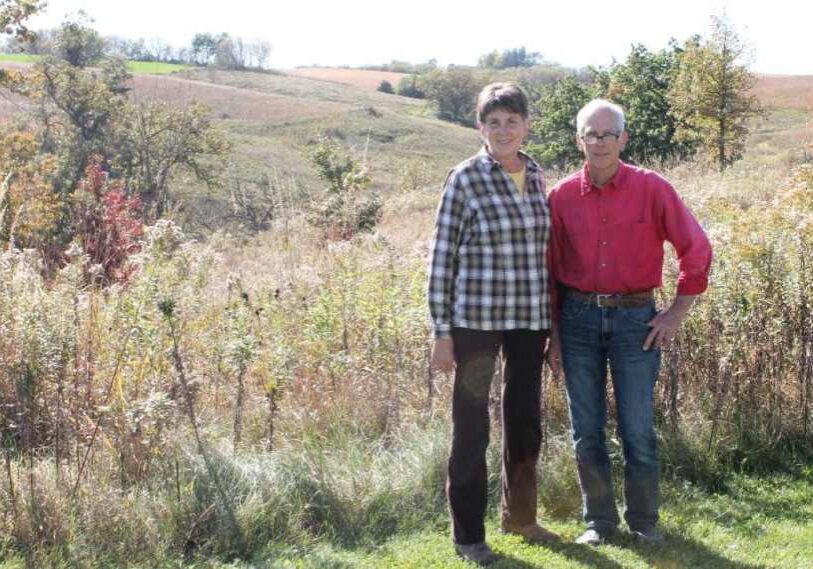To End Erosion at a Former Dam, Engineers Shifting Root River Back to its Original Bed

CARROLTON TOWNSHIP, FILLMORE COUNTY — Each year, up to 40 dump truck loads of soil are stripped from the Root River’s banks and stream bottom at a remote oxbow northwest of Lanesboro.
The massive erosion – worst in high-flow years like 2024 – has altered the river bed, chewed up banks and smothered fish spawning gravel, according to river hydrology experts.
The blame for this ecological mess is a hydroelectric dam and power plant built in 1912-1915. Although abandoned decades ago, its harmful effects linger – just upstream of the Eagle Bluff Environmental Learning Center, where kids are taught about the outdoors and the environment.

Engineers plan to shift the Root River’s North Branch back to its original channel (shown in red) after removing trees that have grown up in the old bed. (Image by G-Cubed Engineering)
Now, in one of the Driftless region’s most ambitious river restoration projects, engineers with excavating equipment intend to force the river back to where it belongs — or at least close to its original course. At a cost of nearly $1million, the 3,300-feet-long channel restoration aims to significantly reduce erosion in the Root River.

Standing at the base of bank that rises 20 feet, Colleen Foehrenbacher, Eagle Bluff Environmental Learning Center’s executive director, shows where the Root River is eroding the Center’s land every year. (Photo by Dan Brown)
In high flows, the river’s unnatural twist at the site slams water into the north bank, eroding a private landowner’s property opposite Eagle Bluff.
“Right now, it does over a 90-degree bend and it doesn’t work at all,” said Geoffrey Griffin, CEO of G-Cubed, a Chatfield engineering firm hired to design and execute the restoration.
Based on historic aerial photos, Griffin estimated that 15 acres of land has been washed down the river so far. “That is just really unbelievable to see how much that river takes — just boom, boom, boom, literally another 10 feet of bank every year,” he added.
20th century progress, 21st century problem
The story of the North Branch’s massive erosion problem begins in 1912 when entrepreneurs started blasting a 1/3-mile-long tunnel through rock to create one of the area’s early hydropower plants.
It was an audacious project that took advantage of a giant oxbow, or horseshoe-shaped bend, on the river. On the upper oxbow, Brightdale Dam was built to direct river water into the tunnel. Turbines at the tunnel outlet supplied electricity to Preston and other towns.

Contractors plan to begin restoring the Root River at this bend. The plan is to shift the riverbed nearly back to its original channel – to the right – where it flowed before a 1912-1915 hydroelectric project altered it. (Photo by Dan Brown)
Power generation at Brightdale ended in the mid-20th century, and the site later became Eagle Bluff Environmental Learning Center (ELC). The dam was removed in 2003. The old turbine house and tunnel remain and won’t be touched in the restoration effort.
The dam site is one of two serious erosion areas on the Eagle Bluff oxbow. Raging waters also eat away the environmental center’s property further downstream, frequently uprooting trees along the bank. After high flows, those trees become submerged hazards called “strainers” on a 3 1/2-mile stretch used for youth canoe classes.

Just downstream from the former Brightdale Dam, bare earth is visible on the bank. An estimated 500 tons of sediment is washed down the river from the old dam site annually. (Photo by Dan Brown)
“We can’t go down the river until we go through and make sure we have cleared out major strainers,” said Eagle Bluff Executive Director Colleen Foehrenbacher. “Staff have to go in the water with chainsaws. We’ve had tractors pulling out the trees.”
A separate $900,000 Root River bank-stabilization project on Eagle Bluff’s land will lower and strengthen the banks and recreate the floodplain.

Eagle Bluff’s Colleen Foehrenbacher stands atop an unnaturally high bank that will be excavated to create a gradually tapered floodplain to reduce erosion. (Photo by Dan Brown)
The money for the work comes mostly from the Minnesota Environmental and Natural Resources Trust Fund, which gets proceeds of the Minnesota State Lottery. Fillmore County Soil and Water Conservation District and Eagle Bluff ELC are overseeing the two projects.
“This is huge,” said conservation district Administrator Dr. Riley Buley, who manages an array of conservation programs and participates in the multi-county Root River One Watershed One Plan. “The goal is to improve water quality and keep soil on the ground. This Brightdale project fits right into that and checks all the boxes.”
Hydrologist Jeff Weiss of the Minnesota Department of Natural Resources said the erosion at the Brightdale site and on Eagle Bluff property degrades the river far downstream. The Root River’s North Branch is classified as “impaired” for turbidity or suspended sediment.
“The sediment fills in pools, reducing their depth, and it can plug up culverts and make flooding worse,” said Weiss.
Fish and aquatic insects also suffer, Weiss said. The North Branch is known for smallmouth bass and other warm-water fish but also holds trout part of the year.
“Fish require clean gravel for spawning,” he added. “That can all be basically smothered by sedimentation.”

Jeff Weiss, a hydrologist for the Minnesota Department of Natural Resources, and Dr. Riley Buley, administrator of the Fillmore County Soil and Water Conservation District, at the abandoned turbine house just below Eagle Bluff. The historic structure won’t be touched during the restoration work. (Photo by Dave Shaffer)
Construction expected the fall and winter of 2024
The river restoration efforts are scheduled for this fall and winter which is unusually late in the year for Minnesota. The reason for the late start: bats.
The old hydro tunnel is now a designated bat hibernaculum, with four species living inside. DNR biologists advised waiting until the bats are inside for the winter which is usually about mid-October.
Both the dam site and Eagle Bluff projects require removal of trees that have grown up on the old river channel or banks. The harvested trunks will be embedded in banks for stability or fish habitat, Griffin and Foehrenbacher said.
At the former dam site, Griffin said, large excavators will dig a new, 3,300-feet-long channel on nearly the same path as the original riverbed. That work should be done in late December.
That channel initially will be left dry, with no flow from the river, so vegetation can take root along banks during the 2025 growing season. Then, in a grand finale, contractors plan in late summer 2025 to redirect the river’s flow into the reconstructed channel by shifting tons of rock and soil.

Colleen Foehrenbacher looks upstream to tree-lined, eroding banks. After high flows, Eagle Bluff workers use chain saws in the river to remove uprooted trees and branches that wash into the flowing water, creating hazards for canoeists. (Photo by Dan Brown)
The bank-stabilization work downstream on the Eagle Bluff property will dramatically lower the 20-feet-high banks and spread soil over about 25 acres. It will be a major change to the landscape.
“During construction, it is going to be pretty upsetting with a lot of bare earth,” said Foehrenbacher. “We are going to end up restoring it to more native landscape. It is probably going to be an oak savannah.”
Timeline of the Brightdale* hydroelectric plant and its consequences
Construction of what would become the Brightdale* power plant commenced in 1912. It remained in operation into the 1940s before being decommissioned. The power plant dam’s eventually removal in 2003 led to erosion and river channeling issues being addressed in 2024.
Timeline Of The Brightdale* Hydroelectric Plant
1912 — Root River Power & Light Co. is formed to build a hydroelectric plant on an oxbow of the North branch of the Root River 3 miles northwest of Lanesboro. Workers begin blasting a tunnel 1,750 feet long through the rock bluff.
1914 — Laborers begin building the Brightdale* Dam to channel water from the upstream side of the oxbow into the tunnel. Work also begins on the power house at the tunnel outlet on the downstream side of the oxbow.
1915 — After completing a transmission line to Preston, the Brightdale plant begins supplying power to 230 customers there. More customers soon are added in Canton and Harmony.
1916-18 — Mabel, Spring Grove. Fountain, Caledonia are Houston connected by transmission lines. Gas-engine generators are added in Preston to meet the new electrical demand.
1928 — Root River Power & Light is sold to Federal Power Service Co., a larger private utility.
1934 — Federal Power sells power plant and distribution system to Minnesota Utilities Co.
1942 — Tri-County Electric Co-op (now MiEnergy Co-op) in Rushford buys the distribution system from Minnesota Utilities Co. Dairyland Power purchases the Brightdale hydropower plant, but dismantles it after a few years.
1951 — Aerial photography shows the no-longer-in-service Brightdale Dam is intact.
1978 — The Forest Resource Center is formed on the power plant site to promote forestry education and research. The abandoned tunnel and empty powerhouse remain.
1995 — Aerial photos show the Brightdale Dam is breached, but it’s unclear when it happened.
1997 — The Forest Resource Center becomes the Eagle Bluff Environmental Learning Center, a nonprofit dedicated to environmental learning and outdoor adventure. Its work continues today.
2003 — Dam is removed, but the river is left with an unnatural 90-degree bend, causing erosion on the north bank and an ever-shifting river channel.
2017 — Minnesota Department of Natural Resources estimates that each year 500 tons of sediment are being eroded at the site, creating problems miles downstream.
2023 — Minnesota Legislature approves $1 million to restore the river channel at the former dam site. Another $866,000 is approved to correct other, unrelated erosion on Eagle Bluff’s property downstream.
2024 — G-Cubed Engineering of Chatfield, the contractor selected to design and execute the restoration, says it will begin work in October, and wrap up the first phase in December.
2025 — After vegetation takes root along the channel dug the prior year, G-Cubed plans to divert the river into the restored riverbed.
*An “s” later was added to the name, and the nearby state forest is called the Brightsdale Forest Management Unit. Timeline sources: Root River Power & Light, A History by A.H. Hanning (1940), The Dairyland Power Story by Harvey Schermerhorn (1973), The Night They Turned on the Lights by Harold Severson (1962), Brightsdale Dam Channel Restoration by Nick Proulx and Jeff Weiss (2022 DNR report), G-Cubed. Photographer: Dan Brown, @dartfishdan on Instagram






